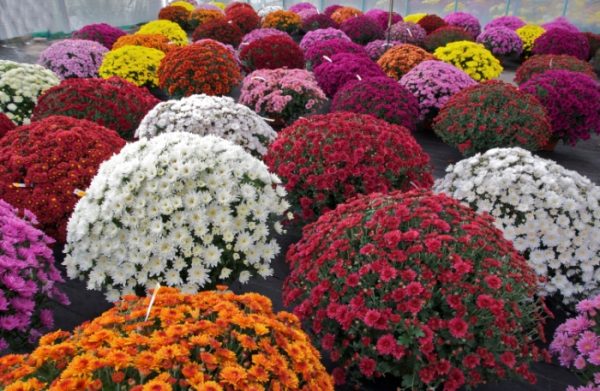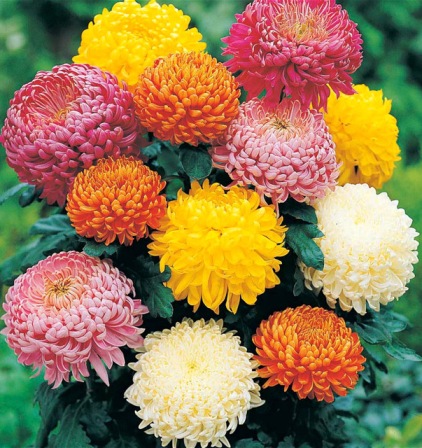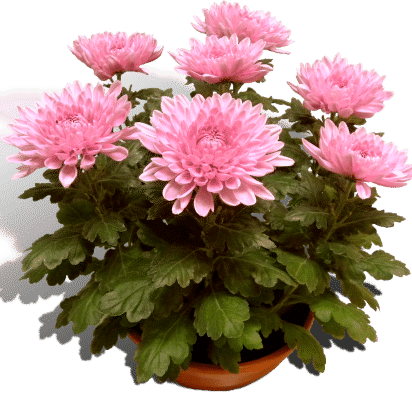Growing Chrysanthemums:
Introduction to Growing Chrysanthemums:- Chrysanthemum is a partially woody erect perennial shrub which may reach up to 1 meter in height with alternative thick leaves. The inflorescence consists of numerous flower heads. Each flower head has numerous florets – the disk florets and ray florets. Chrysanthemums have been originated in the Northern hemisphere ( mainly Europe & Asia). Chrysanthemums can be grown in pots, containers, backyards, polyhouse, greenhouse, and indoors. Commercial Chrysanthemum cultivation brings good profits since loose or cut flowers have excellent demand in local and export markets.
Scientific Name of Chrysanthemums:- Chrysanthemum morifolium.
Family Name of Chrysanthemums:- Asteraceae.
Genus of Chrysanthemums:- Chrysanthemum.
Pollination System of Chrysanthemums:- Cross-pollinated.
Varieties of Chrysanthemums:- Snowball, Potomac, Gypsy Queen, Batik, Harvest Home, Agnishikha, and Ajina Purple are some of the improved varieties grown in India. However, every region has its own high yielding varieties. Contact your department of horticulture for suitable variety.

Climate Requirement for Growing Chrysanthemums:
- Light requirement for Growing Chrysanthemums: Light is one of the most important climatic factors influencing the growth and flowering. The flowers of chrysanthemum are extremely much influenced by the quantum and quality of light; most of the cultivars require shorter days for flower bud initiation and development. Under the long-day condition, chrysanthemum tends to remain vegetative. Because it is a short day plant, then it naturally flowers in fall and winter season.
- Temperature requirement for Growing Chrysanthemums: Based on the temperature requirements chrysanthemum varieties are divided into 3 Classes.
- Thermozero Varieties: These cultivars, which flower at any temperatures between 10 to 27°C, however, most constantly 16°C night temperature.
- Thermopositive Varieties: These types require a minimum of 16°C required for initiation and at 27° C there will be rapid initiation but delayed flowering.
- Thermonegative Varieties: In this cultivars, Bud initiation occur at a low or high temperature between 10°C and 27°C but continuous high-temperature delay bud development.
Growing Chrysanthemums can be successfully carried out at an altitude of 1200 meter elevation (mean sea level). This crop requires an optimum relative humidity of 75 to 90%.
Soil Requirement for Growing Chrysanthemums:- In any agriculture or horticulture crop growing, soil plays a major role in good yields and healthy plants. The ideal soil for chrysanthemum plants growing is a well-drained sandy loam of Great texture and aeration. The soil ought to be neutral or slightly acidic with pH 6.5 to 7.0 having high organic content (humus). Quite light sandy soils aren’t recommended owing to their poor moisture holding properties. In commercial chrysanthemums growing, one should go for a soil test for finding fertility of the soil and other growing conditions.
Land Preparation for Growing Chrysanthemums:- Land should be prepared thoroughly by giving 2 or 3 ploughings to make weed free filed. This can be achieved by removing dead plants or branches from previous crops and crushing any clods from ploughing.
Propagation in Growing Chrysanthemums:- Chrysanthemums are propagated via vegetative method either through root suckers or terminal cuttings.
- Root Suckers: Suckers arise from the underground stem and these are separated and planted in toddlers beds during January for stock plants. Regular pinching is done in these plants for vigorous and profuse branching. Some of these stock plants are used for the preparation of cuttings. The first pinching is rd performed in April, followed by monthly pinching up to June month. Following 3 pinching in the month of June, cuttings should be taken from these mother plants.
- Terminal Cuttings: Cuttings of 6 to 7 cm in length are taken from healthy stock plants in the month of June just before the rainy season. The cuttings are ready by The basal portion (less than a half inch) of cuttings are dipped rooting hormone (1000 ppm solution of IBA.) For greater rooting. Sometimes the lower portion of cuttings is treated with a copper fungicide to avoid fungal growth. These rooted cuttings are prepared for planting in the field.
Season for Growing Chrysanthemums:- Usually, the rainy is best for growing these wonderful flowers. However, they can be grown round the clock (throughout the year) under irrigated and controlled environments such as greenhouse or polyhouse.

Planting and Spacing for Growing Chrysanthemums:- A well-decomposed farmyard manure( F.Y.M). @ 35 to 40 tonnes per hectare should be applied at the time of field/land preparation during last ploughing. Planting of Chrysanthemum on ridges is advised to avoid excessive moisture during the rainy season. Rooted cuttings should be planted at a spacing of 30 cm x 30cm in the month of July. The spacing may depend on variety and planting density.
Irrigation for Growing Chrysanthemums:- Chrysanthemum plants require regular and comprehensive irrigation. If rains are delayed irrigation should be given twice a week in the first month of planting and then at weekly intervals. Don’t over-irrigate the plants and avoid water-logging conditions by providing good draining conditions.
Crop growth regulation and flowering could be modified or Controlled by use of growth regulators. Flower quality and yield may be Improved by using regulators. Spraying GA (50ppm) in 30, 45 and 60, 3 days After planting in the field increases the blossom yield and quality of flowers.
Intercultural Operations in Growing Chrysanthemums:- Timely Intercultural operations in the flower garden is essential for healthy plants and quality flowers.
- Weed Control in Growing Chrysanthemums: Weeding and hoeing are yields normally done manually as and if required, generally 8-10 times annual. Besides, management of weeds that the soil is created loose porous to provide aeration.
- Disbudding in Growing Chrysanthemums: This operation is chiefly done for big flowered and decorative kind chrysanthemum. Disbudding method varies according to the sort of chrysanthemum grown. A number of the varieties are disbudded or regular types, in which the biggest terminal weed is retained and most of the axillary buds(lateral buds) have been eliminated. Disbudding of spray varieties is extremely simple since in this situation only the big apical bud is eliminated and the axillary buds are permitted to develop. There is not any specific rule for disbudding of spray varieties; it varies with the kind of spray produced. When farmers wish to develop three blossoms per plant or one bloom each plant these operations would be most essential. Disbudding operation is an important factor in the maintenance of high-quality Item
- Pinching in Growing Chrysanthemums: Pinching refers to the elimination of the growing tips of the plant to induce the increase of vegetative laterals. It lessens the plant height, promotes axillary branching, delays flowering and aids in breaking rosetting. Pinching is done equally in suckers and in cuttings. It is usually done with thumb and forefinger. Another pinching could be mandatory if the crops create straggly and lean development. Two sorts of pinching are done in chrysanthemum. In gentle pinching, the soft tip of the shoot along with 2 to 3 open leaves is eliminated while in tough pinching a more portion up to tough shoot is eliminated.
- De-suckering in Growing Chrysanthemums: During the vegetative growth stage, plants grow upwards. New suckers continue to grow from the base of crops. For an appropriate and vigorous development of crops, suckers are eliminated from time to time.
Manures and Fertilizers for Growing Chrysanthemums:- Apply farmyard manure as mentioned in irrigation section. Chrysanthemum is a heavy feeder and requires a Substantial amount of Equally Nitrogen ‘N’ and Potassium ‘P’. Nitrogen is required at first phase of plant development and the crops need ‘P’ during the development period of the harvest. As The buds appear, the proportion of ‘K’ needs to be increased and also ‘N’ ought to be reduced. The average N:P:K applied is 400:400:200 kg/ha.

Pests and Diseases in Growing Chrysanthemums:- Finding and controlling pests and diseases in growing Chrysanthemums is a major task.
Pests in Growing Chrysanthemums:
- Aphids in Growing Chrysanthemums: Greenish-black nymphs and chocolate brown adults suck the cell sap out of growing shoots along with the lower surface of leaves. Damage by aphid’s results in loss of vigour, yellowing and premature leaf fall and stunted growth of attacked plants. Honeydew secreted by aphids interrupts the development of sooty mould. The pest also acts as a vector of viral diseases.
- Control Steps: Spraying of Monocrotophos @ 0.05 percent or Phosphamidon @0.02% at 2 to 3 weeks interval controls aphid population effectively. Grubs and adults of Coccinellid beetles prey upon the aphids and effectively wipe out their population.
- Thrips in Growing Chrysanthemums: Slender, white colored nymphs and black adults feed on tender leaves causing silvering, mottling and distortion of leaves. Damaged blossoms look discoloured, withered and dried thanks to scorching. Severe infestation negatively impacts quality and quantity of flower production.
- Control steps: Spraying with Monocrotophos of 0.04% twice or thrice in 2 weeks interval controls thrips population. Drenching the soil with great insecticide also aids in reducing the population.
- Leaf Folder in Growing Chrysanthemums: It occasionally attains a standing of this serious pest on chrysanthemum. Pale-white colored eggs a laid singly or in little groups on the lower side of leaves. Green coloured creatures with brown head fold leaves together and nourish on chlorophyll. The affected leaves become skeletonized and dry. The larvae also damage blossoms.
- Control steps: Cutting and burning infested plant components reduces insect infestation. Two or three sprays of Methyl Parathion or Quinalphos @0.05% gives effective control of leaf folder pests.
- Bud Borer in Growing Chrysanthemums: Female adult deposits around, cream-colored eggs singly on bracts and petals of buds. Larvae feed on growing flowers resulting in considerable blossom reduction or yield.
- Control steps: Collection and destruction of damaged buds and blossoms reduce additional harm. The setting of light traps helps to control the adult population by attracting them. A spray of Methyl Parathion of 0.05% should be carried out at the time of appearance of eggs on buds and tender foliage controls borer damage.
- Hairy Caterpillar in Growing Chrysanthemums: Female moth lays eggs in clusters on a lower side of leaves. Black coloured matured larvae feed voraciously on buds and leaves and cause severe defoliation.
- Control measures: Collection and destruction of egg whites and leaves infested with early larval instars of hairy caterpillar reduce insect build up. Deep ploughing in summer exposes pupae to predators.
- Termites in Growing Chrysanthemums: Termites mainly feed on planets. In the event of severe infestations, they disperse to stem portion of the bark. Attack by the insect becomes intense under dry soil conditions. Damaged plants wilt, dry and finally die if the infestation is extremely high.
- Control steps: Deep ploughing destroys the termite colonies. Proper irrigation and avoiding dry soil conditions prevent pest build-up. Drenching the soil with Chlorpyriphos @ 0.05% prior to planting protects plants from termite attack.
- Lesion Nematode in Growing Chrysanthemums: The nematode causes significant corrosion harm, which subsequently leads to a poor increase of chrysanthemum. The symptoms are in the form of stunting of plants with premature yellowing and drying of leaves, reduced flower size and dark lesions on the roots.
- Control measures: Application of neem cake @ 1 ton per hectare can reduce the nematode population.
- Bud and Leaf Nematode in Growing Chrysanthemums: The nematode causes considerable damage to the foliage of chrysanthemum. Interveinal discolouration of leaves and their passing is the characteristic symptom.
- Control measures: Hot water treatment for suckers at 46°C for 5 to 6 minutes and spraying 0.01% Methyl Parathion on aerial parts is advised.
Diseases in Growing Chrysanthemums:
- Powdery Mildew in Growing Chrysanthemums: Infection is much more acute in older plants under humid conditions. The development of the fungus on the leaves seems to be the powdery coating. Infected leaves turn yellow and dry outside. Infected plants remain stunted and fail to blossom.
- Control steps: Disease may be effectively controlled with Sulphur fungicides. Excellent ventilation and appropriate spacing for free circulation of air are advocated.
- Wilt in Growing Chrysanthemums: Initial symptoms are in the kind of yellowing and browning of leaves. Affected leaves die from the bottom of the plant upward. Infected plants are stunted and frequently fail to generate the blossom. Wilting can cause rotting of root or the bottom of the stem cells.
- Control step: Since the disease is really a soil-borne it is difficult to control with chemicals alone. Drenching the soil with Carbendazim is extremely effective. Since the disease spreads mainly via cuttings, it is important to use disease-free planting material. The disease can likewise be minimised by following strict sanitation; periodical monitoring; harvest rotation and roughing of infected plants.
- Rust in Growing Chrysanthemums: The disease symptoms are in the kind of brownish blister-like swellings, which show up on the undersides of leaves. Severely infected plants become quite weak and fail to bloom properly.
- Control steps: Early elimination of infected leaves/plants helps to protect against the additional spread of this disease. Spraying the plants with dusting with Wettable Sulphur @ 0.2 percent is effective in controlling the disease.
- Septoria Leaf Spot in Growing Chrysanthemums: Leaf spots happen during cool-wet periods of this rainy season. Since the germs are dispersed throughout rain splashes the lowermost leaves become infected first. Serious infection might result in the premature withering of the leaves; the lifeless leaves hang to the stem for some time. When flowering begins the infection occurs on flower buds, which rust completely.
- Control steps: This disease could be controlled by spraying Bavistin @0.05 percent six times at two weeks intervals at the end of July or spraying Benomyl (0.1 percent) followed by Captafol (0.2 percent) and Carbendazim (0.1 percent).
- Stem Rot in Growing Chrysanthemums: The affected plants show different symptoms like leaf chlorosis, necrosis, decay and discoloration of an internal portion of the stem cells. After the flower buds are about to start, little dark stripes are observed at the bottom of the stem. In several instances, the infection is devoid of any external symptoms and follicles also seem healthy. In some circumstances root and stem rot are confined to one side of the stem, then another side remaining healthy.
- Control steps: Cuttings should be taken from healthy plants. Following strict field sanitation, roughing of infected plants and crop rotation can help to minimize the disease incidence. Spraying with Bavistin (0.1 percent) and avoiding excessive moisture in beds assist in checking the disease.
Note: Your local horticulture department is a good source for finding information about pests and diseases in Growing Chrysanthemums. Don’t experiment on your own without knowing the symptoms and causes.
Harvesting in Growing Chrysanthemums:- The right period of harvesting depends upon the cultivar, marketing, and purposes etc.. Normally, harvesting is done early in the morning. The stalks are cut 20 cm from the ground and are accumulated in trays or buckets containing cold water at 15 to 18°C plus a floral preservative (Silver nitrate 25 ppm). The harvested stems are kept in 1000 ppm Silver nitrate, for 10 seconds-10 minutes followed by placing in deionized water to prevent the congestion of xylem from the microorganisms
The flowers are harvested 3 weeks from the date of planting in an interval of four days. For floral decoration and garlands, fully opened flowers are plucked with or without the peduncle. Flowers are packaged loose in bamboo baskets or gunny bags and shipped to retail markets available.
Harvesting of Chrysanthemum Cut flowers based on variety.
Standard cultivar:
- Period of Harvest: When 40 to 50% of the bloom is fully open
Dwarf cultivar:
- Period of Harvest: When 80 to 85% of the blooms has opened.
Spray cultivar:
- Period of Harvest: When 40 to 50% of the bloom has opened.
Single:
- Period of Harvest: When the maximum number of flowers open, but before the pollen shed from the outer row of the disc florets.
Anemone:
- Period of Harvest: Before the central cushion in the top most flowering fully developed.
Post-Harvesting in Growing Chrysanthemums:
- Grading in Growing Chrysanthemums: Chrysanthemums are rated depending on the stem length, blossom appearance, variety of flowers, stem straightness, color and freshness of blossoms. Standard chrysanthemum is rated in Blue, Red, Green, and Yellow, whereas spray forms are rated into Gold, Silver, and Bronze dependent on the quality parameters.
- Packaging in Growing Chrysanthemums: the majority of the typical chrysanthemums are put in sleeves and packaged in display boxes measuring 90 cm x 43 cm x 15 cm. They’re set in the boxes according to the ranges. For bulk packing of this spray chrysanthemums, 10, 15 or 20 stalks are put in sleeves according to the ranges. Six sleeves, three in the end, are usually packed in every box, measuring 80 cm x 50 cm x 23 cm.
- Cold Storage in Growing Chrysanthemums: The stalks in the buckets (after grading) have been given a cut using a sharp blade and pre-cooled at 1°C minimum of 2 hours prior to packing. Chrysanthemum could be stored for 3 to 6 months period in 0 to 3°C.
Yield in Growing Chrysanthemums:- Chrysanthemum flower yield depends on many factors such as soil fertility, irrigation/climate , planting method, Area of cultivation ( open field or controlled environment), and other garden management practices. The average yield of Chrysanthemum loose flowers varies widely from 10 to 15 tonnes per hectare.
Marketing in Growing Chrysanthemums:- Marketing of cut flowers or loose flowers can be transported to local flower markets.
